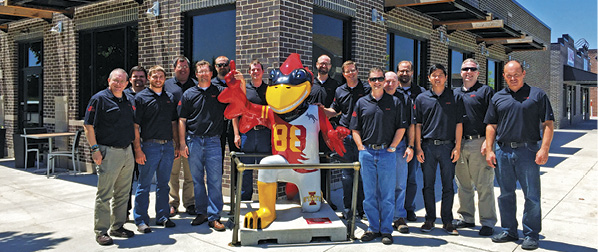Specifying Pneumatic Cylinders – Part 2
Air cylinders are offered in a variety of industry standards. Within these standards, air cylinders come in an assortment of shapes, sizes, and types, as well as with numerous optional features. At first glance, the number of permutations can be a bit overwhelming. The good news is that each pneumatic actuator type and configuration has a place in today’s motion-centric automation environment.
Even though the air cylinder market includes a multitude of standard options, pneumatic actuators are still selected by their ability to perform a specific function. Sometimes the job at hand simply falls outside the standard product offering, however, and only a tailored or custom air cylinder will suffice. The development of custom air cylinders can often be both expensive and time consuming. Part 1 of this article (in the January/February 2015 issue) outlined the first four steps in this selection process, and the list continues below.
5. Room Availability
At this point, you have figured out how much room your cylinder will require and compared it to the room you have available. You either know exactly what you need, or you know the better part of what you need.
6. Specialty Cylinder Applications
Specialty cylinder considerations begin now that you have addressed the preliminary questions and found no standard cylinder to meet your specific requirements. You are left with a few more questions.
What Type of Cylinder Best Suits My Needs?
When designing a custom cylinder, it’s easier if your start with a particular family of cylinders, i.e. NPFA interchangeable, compact, non-repairable, etc., that will be conducive to your application.
- Is the application very heavy duty? Is there plenty of room available? (If the answer is yes, then you may wish to start with an NFPA-style cylinder.)
- Is real estate at a premium? (If yes, then you may be forced into starting with a compact style.)
- Is price the main concern? (If so, then a non-repairable unit may become your first choice.)
Remember that you have several choices. Once you have determined the style of cylinder, you can get to the details of your design.
You probably know how you plan to mount the unit. But often times you find that mounting will require a special bolt pattern or mounting style that is non-standard. You’ll have to ask how the style of cylinder you have selected can be modified to fit the pattern for a minimum cost. Will it require that special parts be manufactured? Will it need unique mounting hardware, such as plates, flanges, or brackets?
In cases where the mount is built into or uniquely attached to your cylinder, costs will increase along with manufacturing lead times. So beware. For example, nose mounting might require that unique end caps be produced. Integral lug mounts could require special extrusions, welding, or other creative attachment concept to be employed. In lieu of lugs, is there room to drill and tap your cylinder’s end caps (or body) with special bottom or side-mounting holes? Would you have enough depth of thread?
7. Motion Elements
Now you’ll want to address the motion elements of your cylinder. Are there special movements, sensing, or side loads being applied that will require special modifications to the cylinder? If so, you’ll need to accommodate them.
- Must the load stop at any intermediate position?
3-Position Cylinders
You’re in luck. You can get three or more rod positions from a single cylinder! Many cylinder styles are offered with 3-position options. The short-stroke tie rod cylinder shown in Fig. 8 is essentially two cylinder bodies combined in a single package. You can specify the same or different stroke lengths to set your work positions as required. Nice!

4-Position Cylinders
More luck! You can also get numerous cylinder styles in back-to-back configurations that enable positioning at up to four end points. As the name implies, two single-rod cylinders are assembled with their back end caps attached. As shown in Fig. 9, by anchoring one rod end and allowing the cylinder body to “float,” four distinct end points can be obtained.
- Can the load be allowed to rotate slightly?
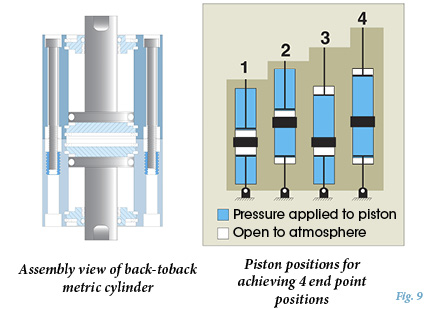
Non-Rotating Options
For applications in which anti-rotation and registration are critical, there are solutions. Maintaining the load’s fixed orientation can be accomplished in several ways.
The drawing in Fig. 10 shows one method used on tie rod cylinders. Two guide pins incorporated inside the cylinder pass through the piston head. These guide pins prevent rotation of the rod with a tolerance of ±1°. A rubber disk is included at the end of each guide pin to take up end play and firmly seat the pins in the precision guide pin holes.
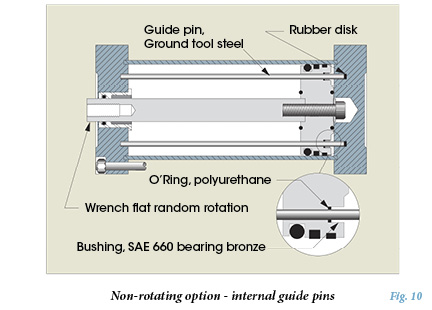
Because the guide pins are inside the cylinder, they are protected from the environment, physical damage, and are lubricated by the system lubrication. They require no additional space, leaving the rod end area free for attachments and tooling as required by your application. Internal guide pins are also available on a number of short-stroke cylinder models like the Pancake® series shown in the figure.
External Non-Rotating Options
Another solution uses an external guide block securely attached to the piston rod. A steel guide shaft, attached to the guide block, assures anti-rotation of less than 0.8° (Fig. 11).
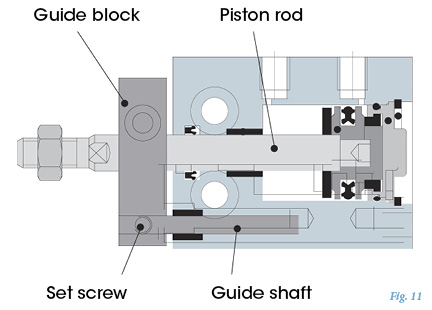
Twin Rod, Non-Rotating Options
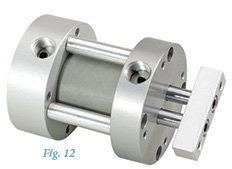 Twin piston rods are incorporated into the cylinder head to provide
Twin piston rods are incorporated into the cylinder head to provide
anti-rotation. The rods are securely fastened to the piston and tied together externally by a rod end tool bar. The tool bar ensures that the rods move in tandem and provides an ideal mounting surface for attachments required by your application. The tool bar is furnished with threaded mounting holes or optional counter-bored mounting holes (Fig. 12).
Stroke Adjustment
Stroke adjust styles may also be needed when the stroke can change either on the extension or the retraction of the unit.
Adjustable Retract Stroke
An adjusting screw with a thread-sealing locknut mounted in the rear end cap provides a simple, yet rugged adjustment of the cylinder stroke in the retract direction. A fine thread on the adjusting screw will provide precision adjustment. Adjustable retract strokes are offered as optional features for many cylinder styles (Fig. 13).
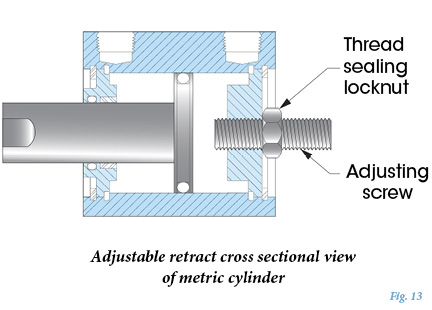
Adjustable Extend Stroke
It is possible to use the back end of a double rod cylinder to adjust the extend stroke. A stop collar, bumper, and some kind of impact plate could do the trick. However, if taking this approach, use caution and consider a safety cover to avoid leaving the pinch point exposed (Fig. 14).
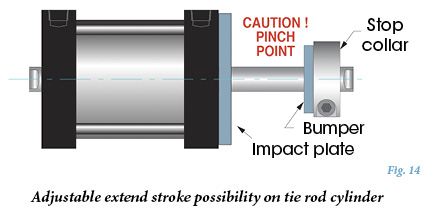
Position Sensing
Sensing can often change the cylinder based on the type of sensing needed. Standard electronic switching will require magnets to be added to the piston. Proximity switching may require internal or external changes to the cylinder so that the sensing probes will have targets they can read. Transducers may also require a variety of internal or external changes to a unit.
Side Loads
Side loads often suggest a need for such items such as stop tubes or heavier bushings because of the wear produced when the cylinder is in motion (Fig. 15).
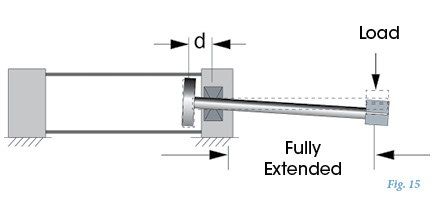
- Will the cylinder have strong side loading or heavy overhung loading?
Cylinder piston rods are supported by a bearing in the front head of the cylinder and the piston itself running inside the cylinder walls. As the rod nears full extension, the distance (“d”) between support surfaces becomes shorter. The piston rod assembly tends to cock, causing uneven wear on the bearing surfaces and shortening seal life.
Stop Tubes
One solution to the problem is to install an internal stop tube. The stop tube blocks the piston from reaching the front head, thereby increasing the minimum distance between support points. Component wear is reduced, and cylinder operating life is extended. However, in order to maintain the same work stroke, the length of the cylinder body must be increased by the length of the stop tube. Dealing with the increased package size may present issues (Fig. 16).
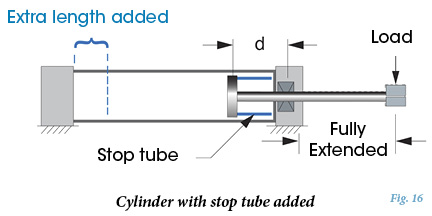
Double Rod Cylinders
If you have room available, a double rod cylinder gives you the best piston rod assembly support. You’ll have rod bearings in both end caps, reducing the load on the piston. And you’ll have maximum distance between support points (Fig. 17).
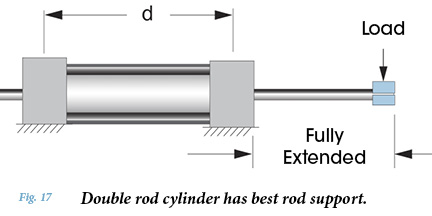
8. Environmental Issues
Lastly, we come to the environment. External issues should be addressed first before considering internal issues.
(1) External issues are items that will cause harm to the outside of the cylinder. Certain “wash down” or wet environments often require that material changes be made to the basic cylinder components. End caps, tubing, tie rods, etc., might have to be made of stainless steel or a unique type of plastic. If not material changes, then a chemical coating process may be required in order to use the cylinder in a hostile environment. Heat may be another external issue that demands material changes.
(2) Internal issues address fluids being used to operate the cylinder, as well as contaminants that could enter into the cylinder. If fluids other than air are required to run the cylinder, then seal changes may be needed. When aggressive items are trying to enter into the unit, rod wipers or scrapers may be needed. External chemicals may affect the internal components, too. Seal materials may need to change.
Special cylinder applications can get quite complicated. But by providing your cylinder manufacturer with the answers to these questions, you will greatly help them in their efforts to provide exactly what you need.
Keep in mind that each deviation from the standard product may cause special parts to be manufactured, purchased, and/or designed. When you are looking at your next design project, we would suggest that you try to fit it into a standard product if at all possible. The fewer parts that have to change (from a standard product), the less likely the cost will have to increase. However, when a total custom cylinder order is required, you will need to plan on a longer lead time because these items will be designed to your specific needs.
Reinforce your industry expertise with a Pneumatic Mechanic, Technician, or Specialist certification. Apply online at www.ifps.org.
Read Part 1 of this article here.




